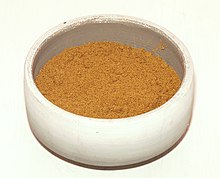| Revision as of 11:29, 11 August 2022 editPopcornfud (talk | contribs)Extended confirmed users, IP block exemptions, Rollbackers71,950 editsNo edit summaryTag: Visual edit← Previous edit | Revision as of 11:29, 11 August 2022 edit undoPopcornfud (talk | contribs)Extended confirmed users, IP block exemptions, Rollbackers71,950 edits Changing short description from "North African spice or seasoning mix" to "North African spice mix"Tag: Shortdesc helperNext edit → | ||
| Line 1: | Line 1: | ||
| {{Short description|North African spice |
{{Short description|North African spice mix}} | ||
| {{More footnotes|date=April 2009}} | {{More footnotes|date=April 2009}} | ||
| ] | ] | ||
Revision as of 11:29, 11 August 2022
North African spice mix| This article includes a list of general references, but it lacks sufficient corresponding inline citations. Please help to improve this article by introducing more precise citations. (April 2009) (Learn how and when to remove this message) |

Ras el hanout or rass el hanout (Template:Lang-ar raʾs al-ḥānūt, Template:IPA-ar) is a spice mix found in varying forms in Tunisia, Algeria, and Morocco. The name in Arabic means "head of the shop" and implies a mixture of the best spices the seller has to offer. Ras el hanout is used in many savory dishes, sometimes rubbed on meat or fish, or stirred into couscous, pasta or rice.
There is no definitive composition of spices that makes up ras el hanout. Each shop, company, or family may have their own blend. The mixture usually consists of over a dozen spices, in different proportions. Common ingredients include cardamom, cumin, clove, cinnamon, nutmeg, mace, allspice, dry ginger, chili peppers, coriander seed, peppercorn, sweet and hot paprika, fenugreek, and dry turmeric. Some spices may be particular to the region, such as ash berries, chufa, grains of paradise, orris root, monk's pepper, cubebs, dried rosebud, fennel seed or aniseed, galangal, long pepper. Ingredients may be toasted before being ground or pounded in a mortar and mixed together. Some preparations include salt or sugar, but that is generally not the accepted practice. Garlic, saffron, nuts or dry herbs are generally not included, as they are usually added to dishes individually, but some commercial preparations, particularly in Europe and North America, may contain them.
Certain supposed aphrodisiacs, including the notoriously dangerous "green metallic beetles", cantharides, have appeared in many Moroccan ras el hanout formulations, but these seem to be irrelevant for flavouring purposes.
Notes
- ^ Alan Davidson (21 August 2014). The Oxford Companion to Food. Oxford: Oxford University Press. pp. 671–672. ISBN 978-0-19-104072-6.
- "Ras el hanout" at bbc.com (retrieved 3 August 2016)
References
- The Gourmet Cookbook, by Ruth Reichl (Ed.), Houghton Mifflin. ISBN 0-618-37408-6
- The Oxford Companion to Food, by Alan Davidson, Oxford University Press. ISBN 0-19-211579-0
| Algerian cuisine | |
|---|---|
| Dishes | |
| Soups | |
| Brochettes | |
| Ingredients | |
| Beverages | |
| Desserts and pastries | |
| Related | |
| Moroccan cuisine | |
|---|---|
| Dishes (list) | |
| Brochettes | |
| Ingredients | |
| Soups | |
| Breads | |
| Desserts & pastries | |
| Beverages | |
| Related cuisines | |
| Cuisine of Tunisia | |
|---|---|
| Breads, dishes, and soups | |
| Ingredients | |
| Beverages | |
| Desserts and pastries | |
| Related | |
This Arab cuisine–related article is a stub. You can help Misplaced Pages by expanding it. |
This spice mix-related article is a stub. You can help Misplaced Pages by expanding it. |